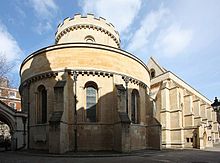
Back Temple Church Afrikaans كنيسه المعبد (مدينه لندن) ARZ টেম্পল গির্জা Bengali/Bangla Església del Temple Catalan Temple Church Danish Temple Church German Templana Preĝejo (Londono) Esperanto Iglesia del Temple (Londres) Spanish کلیسای تمپل Persian Temple Church Finnish
| Temple Church | |
|---|---|
 Temple Church, view from south-west, showing the original Round Church, now forming the narthex | |
 | |
| Location | London, EC4 |
| Denomination | Church of England |
| Previous denomination | Roman Catholic |
| Churchmanship | Book of Common Prayer |
| Website | templechurch |
| History | |
| Consecrated | 10 February 1185 |
| Architecture | |
| Functional status | Active |
| Administration | |
| Diocese | London |
| Deanery | City |
| Clergy | |
| Priest(s) | Robin Griffith-Jones (Master of the Temple) Mark Hatcher (Reader of the Temple) |
| Laity | |
| Director of music | Thomas Allery |
 Temple Church, view from south-east showing the chancel and east end | |
Listed Building – Grade I | |
| Official name | Temple Church (St Mary's) |
| Designated | 4 January 1950 |
| Reference no. | 1064646[1] |
The Temple Church, a royal peculiar in the Church of England,[2] is a church in the Inner and Middle Temples located between Fleet Street and the River Thames, built by the Knights Templar for their English headquarters in the Temple precinct. It was consecrated on 10 February 1185[3] by Patriarch Heraclius of Jerusalem.[4] During the reign of King John (1199–1216) it served as the royal treasury, supported by the role of the Knights Templar as proto-international bankers. It is now jointly owned by the Inner Temple and Middle Temple[5] Inns of Court, bases of the English legal profession. It is famous for being a round church, a common design feature for Knights Templar churches,[6] and for its 13th- and 14th-century stone effigies. It was heavily damaged by German bombing during World War II and has since been greatly restored and rebuilt.
The area around the Temple Church is still known as the Temple.[7] Temple Bar, a jurisdictional gateway, stood in the middle of Fleet Street in the Temple area. Nearby is Temple Underground station.
- ^ Historic England. "Temple Church (St Mary's) (1064646)". National Heritage List for England. Retrieved 25 November 2016.
- ^ Inner Temple Library website (retrieved 10 August 2018)
- ^ "The City of London Churches: monuments of another age" Quantrill, E; Quantrill, M p44: London; Quartet; 1975
- ^ "FOUNDATION-THE KNIGHTS TEMPLAR". Temple Church. Archived from the original on 9 February 2019. Retrieved 8 February 2019.
- ^ Archives of the Honourable Society of the Inner Temple, TEM: Records of adminstration [sic] of the Temple Church (1613–1996)[1]
- ^ "The Round Church". Temple Church. Archived from the original on 9 February 2019. Retrieved 8 February 2019.
- ^ Amanda Ruggeri (13 May 2016). "The hidden world of the Knights Templar". BBC Travel. Retrieved 8 February 2019.